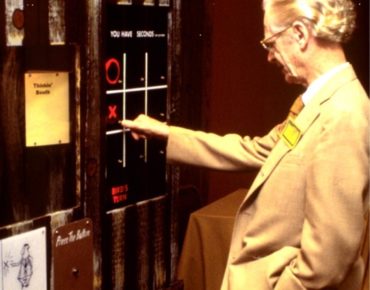Fake Artificial Intelligence vs. the Real Thing – How to Tell the Difference

B.F. Skinner Plays tic-tac-toe
When ‘Willy the Wonder-Chicken’ defeated famed behavior psychologist B.F. Skinner at Tic-Tac-Toe in 19791, who would’ve imagined tomorrow’s McNugget would become a foot soldier in the battle between artificial intelligence and carnival barkers. Today, we suffer a never-ending stream of pseudo-tech articles predicting either an AI-induced dystopia or dismissing AI as a cyber parlor trick. Despite the hype, AI has made steady advancement into a widening spectrum of industries. As technologists, we are called to spot and exploit emerging tech while dancing through a minefield of false promises, super-charged buzzwords, and freshly polished pitches of old technology. Unfortunately, all too often this leaves us as befuddled as B.F. Skinner watching Willy casually win his sixth consecutive victory.
Artificial Intelligence is cracking the code on a whole family of non-procedural problems, such as image recognition, autonomous systems and anomaly detection. Our research team recently completed detailed studies on how user behavior analytics is changing cyber security and operations analytics is accurately predicting impending system failures. These are but a few examples of legitimate AI game changers. However, these wins are often elbowed aside by a throng of last-generation products dressed up in new AI bikinis. So how can we spot the difference without completing a degree in Computational Learning Theory?
Take the Wonder-Chicken which astounded his opponents with apparent cunning and gamesmanship, while in reality was just applying easily conditioned rules to get fed. Willy was savvy but not smart. Savvy systems merely apply pre-programmed rules, logic, and inferences to existing knowledge. Yet savvy systems can solve an amazing array of complex problems, from controlling a nuclear power plant to landing an airliner without spilling the pilot’s drink.
Smart systems, on the other hand, are more like Inky the Outgoing Octopus. Inky once lived in a large tank in New Zealand’s Napier Aquarium. I say ‘once’ because in the dark of night, Inky waited for the staff to leave the building, slid the tank’s plexiglass lid slightly ajar, contorted himself through the one-inch gap, climbed up and out of the tank, lowered himself to the floor, tentacled his way across the room, pried open the grate on the drainpipe, and amoeba-ed his way through 164 feet of plumbing to Pacific freedom. Now that’s a smart cephalopod. Likewise, smart systems ingest copious amounts of information, discover patterns in the data, learn from these patterns, and apply this learning in new situations.
So how do you spot savvy dressed up as smart? Well, one cold truth about real AI is smart requires learning and learning requires data … and a lot of it. As such, examining a potential solution along these two axes will quickly determine whether engineering or marketing designed the product.
AI is very real and very powerful. But so is marketing. Therefore, we must separate hyperbole from reality, discerning savvy from smart. A quick barrage of well-crafted questions can provide an effective litmus test. Because in today’s emerging technology, no one needs a Wonder-Chicken.
Mark Campbell is the Chief Innovation Officer at Trace3.
Footnotes:
1: The Chicken Vanishes, U. S. Journal, February 8, 1999
2: Inky the Octopus Escapes from a New Zealand Aquarium, NY Times, April 13, 2016
3: In rare cases, pre-training can be a Smart idea. For example, in malware detection, it is much better to pre-train than unleash a shedload of viruses into your network.











